This might sound strange, but I love it when my little readers make mistakes. And it’s definitely not because I want to see them fail!
Rather, seeing those mistakes gives me incredible information about what my students can do, as well as what they’re not yet doing. It helps me figure out what decoding strategies to teach, what phonics patterns they need to work on, and what kind of coaching I can use to best support them.
In today’s post, I’m going to share exactly how I use running records to analyze students’ decoding errors in order to gain information about them as readers. I also have some freebies that will help you better understand exactly what your students need!
(Note: this post is part of a 6-post series on reading interventions! If you missed the first post in the series, you can check it out here.

How to Gather Information About Students’ Decoding Errors
There are many different literacy assessments out there that can give us data about our students’ reading. And although it’s one of the simplest assessments out there, the running record is one of my favorites.
When you take a running record, you not only record when students make mistakes, but you also write down their miscues (the word(s) they say instead of the correct word) and self-corrections (when they fix up their mistakes). Students’ miscues and self-corrections give you information about what they are doing while they read, as well as what they are not yet doing. Knowing this is incredibly valuable because it helps you figure out what to teach your kiddos next!
Here’s an example:
A student is reading the sentence, “We looked at the bridge” on a page where the photo shows two children looking at a bridge.
If the child reads, “We looked at the book” and does not correct the error, this tells me a couple of things. First, the child uses the first letter of a word when attempting to decode an unfamiliar word. Second, the child is paying attention to sentence structure (the sentence still sounds right despite the mistake).
However, the child is not reading all the way through the word, and the child is not consistently attending to meaning (she should have realized that “bridge” doesn’t make sense).
That one tiny mistake gives us a lot of potential information about that reader. If the reader continues to make similar errors throughout the rest of the book, this provides further support for our inferences about what the reader is and is not doing.
Getting Ready to Take a Running Record
So how do you prepare for a running record? Well, the nice thing is that getting ready is pretty simple.
First, choose a text that will be at the student’s instructional level. Read the book (if you haven’t already), grab a blank running record form, and prepare a couple of comprehension prompts.
If you need free running record forms, sign up to receive them by clicking HERE – but be sure to read the rest of this post so you’ll know how to use them!
Then, carve out time to give the running record to the student. Since it’s a one-on-one assessment, this can get tricky. I like to build running records into my small group time, so that I’m doing them on a consistent basis.
When my students sit down at the table to begin a small group lesson, they reread familiar texts from the group’s book box. Meanwhile, I grab the book that we read during the previous lesson and have one student read it to me. I take a running record of the child’s reading and ask a few comprehension questions afterward.
As a classroom teacher, I took one running record per group per day. This way, I got through my entire class about once a month. I do take running records on some students more frequently, because their group is “lower” and is meeting with me more often than the other groups. This is a good thing, because it allows me to keep a close eye on my struggling readers’ progress.
Taking the Running Record
When you take a running record, you have to move fast! The more you can write down about a child’s miscues and reading behaviors, the better. If you’re just starting out with running records, you may find it tricky to keep up with a child’s reading. The more you practice, the easier it’ll be (although I still don’t catch everything if a child is reading quickly).
Sometimes, you’ll have a running record that contains the words of the text. Reading A to Z has some books that come with running records, as does the Fountas and Pinnell Benchmark Assessment System.
However, you can just as easily take a running record on a blank form or even a blank sheet of paper if you’re in a pinch! Let’s take a look at how you would take a running record using a blank form.
First, let’s imagine that a student is reading this text. Here is a layout of the complete text:
Watch this video to see how I take a basic running record (I don’t actually have a student with me during the video, so you’ll have to use your imagination!). You can follow along with the actual text using the images above.
There are different ways to mark down reading behaviors and errors. Always stick with the system agreed upon by your team or school, for purposes of consistency.
You can take a look at the Reading A to Z running record scoring suggestions, as well as Heinemann’s version. If your team or school doesn’t have an agreed-upon system, perhaps you can initiate that conversation. Consistency in this area can be helpful when a team is examining student assessment data.
Reviewing the Running Record
Once you’ve taken the running record, take a few minutes to look it over. Although I don’t always have time to look over my running records the same day that I take them, I always sit down with a pile of them at least once a week. I use the information I gather in order to plan next week’s instruction.
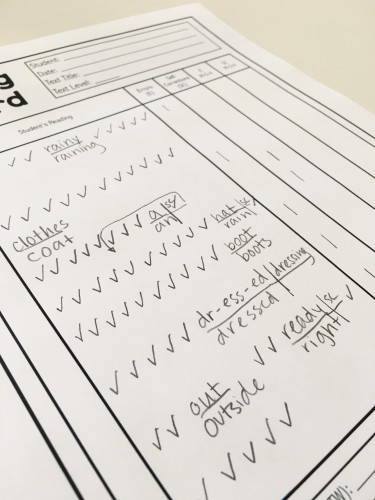
First, count up the number of errors. Take the number of words read correctly (WC), divide that by the total number of words in the book (TW), and then multiply that number by 100 (WC / TW x 100). That will give you the percent of total words read accurately.
In the running record in the video, the “reader” made 5 errors (we don’t count the ones he self-corrected). There were 74 total words (TW), so he read 69 of them correctly (WC).
69 / 74 x 100 = 93. The child read this book with 93% accuracy.
The percent of words read correctly gives us some information about whether this book and the child were a good match. When a beginning reader can read a text with 95% accuracy or higher, that book is at the child’s independent level. She can read it without support, on her own.
When a beginning reader reads a text with 90%-94% accuracy, we consider the text to be at her instructional level. The imaginary child in my running record read this text with 93% accuracy, indicating that this text is probably at his instructional level.
Reading a text with lower than 90% accuracy generally means that the text is too difficult for the reader.
By itself, however, the accuracy percentage doesn’t tell the whole story.
We also have to take a look at comprehension and fluency. I’m not going to dive deep into either of these areas, because decoding is the focus of this blog post series. However, it’s important to look at comprehension when considering instructional level. Even if a child reads a text with a high level of accuracy, it’s not at his instructional level if his comprehension of the text is poor. We shouldn’t choose books for our students that they cannot comprehend at all, because even supportive teaching will not be enough to help the child “bridge the gap” and understand the text.
It’s also important to consider fluency when determining an instructional level. A child may read a book with good accuracy and comprehension – but if it takes the student half an hour to finish the book, then it’s not a good choice for guided reading time! To quickly rate a child’s fluency on a running record, I like to jot down a number between 1 and 3 (1 = disfluent, 2 = somewhat fluent, and 3 = fluent). It’s very simple, and I can elaborate with notes, but it’s a quick and easy way to address fluency on a running record.
In the free intervention toolkit, I’ve included several different running record forms to help you calculate reading accuracy, rate comprehension, and score fluency. Again, you can sign up to receive those intervention materials here:
How to Get Valuable Information by Searching for Error (and Success) Patterns
But wait…there’s more!! Even after I’ve scored the running record for accuracy, I’m not done looking at it. Now it’s time to use all this information to draw conclusions about the reader.
By looking at the words that a child misread, I can figure out what phonics patterns he/she needs to work on. Here is a list of some of the things I look for with beginning readers (this list is also included in the free intervention toolkit that you can sign up for above):
- Use of word parts – Does the child use word beginnings (first letter or letters)? Attend to the middle of words? Read the ends of words correctly? What about inflected endings (-ing, -ed, -s, -es)?
- Knowledge of specific spelling patterns – Does the child stumble on digraphs or blends? What about glued sounds?
- Use of vowel sound knowledge – Does the child read short/long vowel sounds correctly? Which vowels does the child read correctly/incorrectly? How does the reader do with vowel spelling patterns that consist of more than one letter? Does the student try different vowel sounds when one doesn’t sound right?
- Recognition of high frequency words – Does the child apply high frequency word knowledge to his reading? Is he recognizing and reading high frequency words quickly? Is there a difference between the child’s ability to read high frequency words out of context vs. in a text?
In addition to considering a child’s word reading habits, I also look for information about his general reading behaviors. I search to find out if the child is:
- Using different strategies to decode tricky words, when needed
- Making multiple attempts at a tricky word
- Appealing for help
- Rerunning (going back and rereading during tricky parts, when he is confused, or to gain more meaning from a sentence)
- Self correcting at a rate of 1:5 or better (to find the self-correction ratio, add the number of self corrections to the number of errors, then divide that by the number of self-corrections – see my free running record sheets for more details)
I also look at fluency (attention to punctuation, smooth reading, expression, etc.), but I won’t go into that here since our focus is decoding.
When you download the free intervention toolkit (sign up below the photos), you will find several different types of running record forms. These “at a glance” forms will help you quickly find and summarize information about students’ error patterns and reading behaviors!
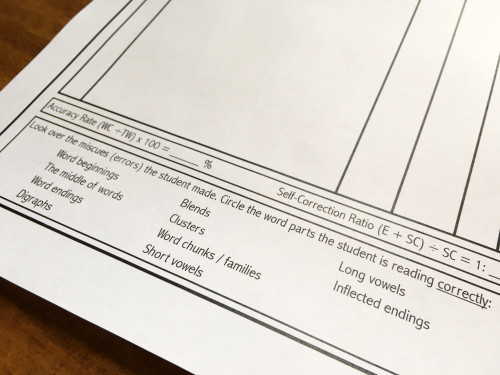
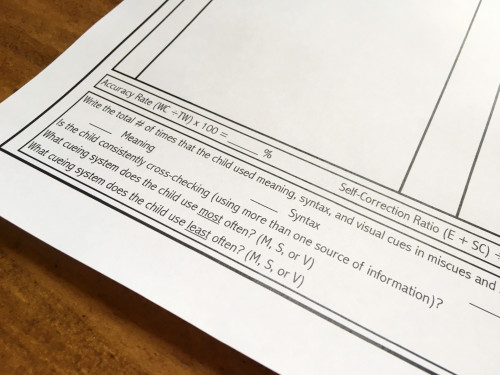
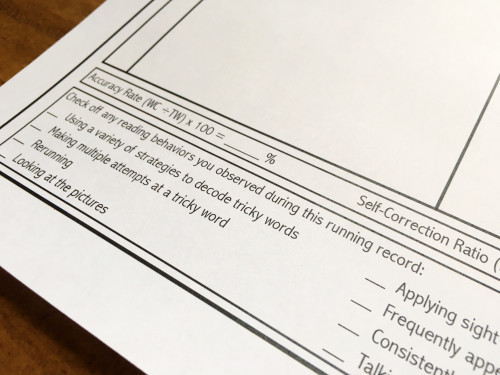
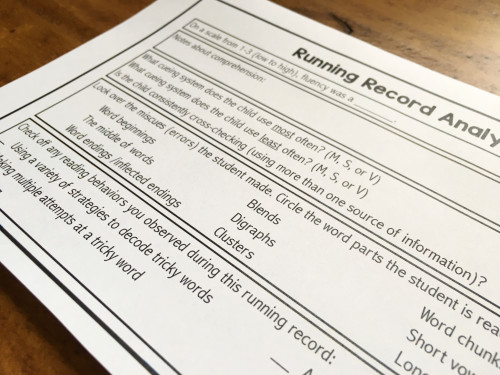
What Should We Do With All This Information?
Running records can truly serve as a gold mine for information about students’ reading. However, all the data we get is only valuable when we use it to take action!
To continue exploring how to support your students (especially your struggling readers) with decoding, check out the rest of the blog posts in this (now finished) series:
What Causes Decoding Difficulties in Beginning Readers, and What Can Teachers Do About It?
How to Teach Decoding Strategies to Struggling Readers
Phonological Awareness Interventions for Struggling Readers
Phonics Interventions for Struggling Readers in K-2
How To Give Struggling Readers More Practice Time Through Volume Reading
Happy teaching!
Resources
Pinnell, G. S., & Fountas, I. C. (2009). When readers struggle: Teaching that works. Heinemann.


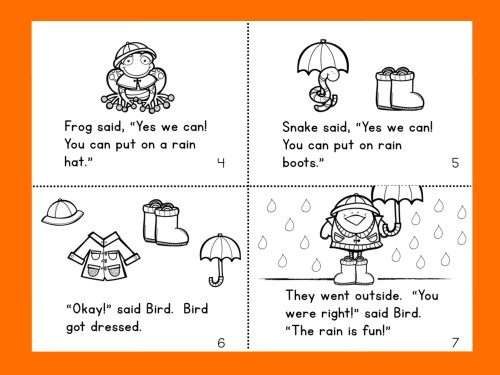




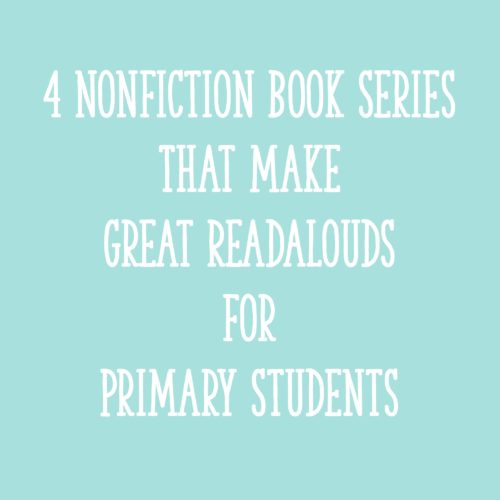
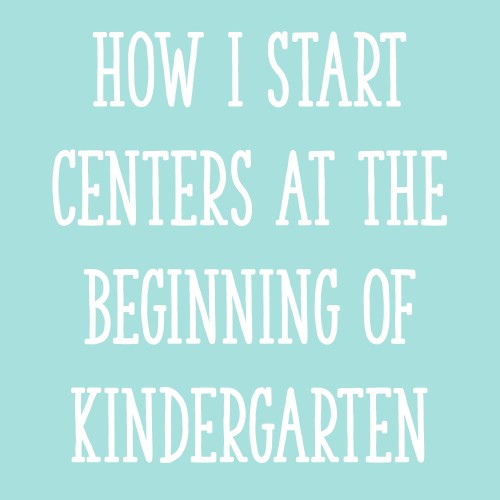






Great article …I refreshed different ways to look at a running record.
Thank you, Charlene! So glad it was helpful! Alison
Thank you so much for this amazing article. It has so much information and freebies that I’ll be using soon.
I’m so glad it’s helpful, Margarita! Thanks for reading and commenting. 🙂 Alison
Fantastic explanations Alison! Wish I had this when I was teaching 30 years ago! Teach 4 year olds about pre-reading sounds and letters now, but I sub as well so now I have this knowlege. Thank you for sharing!!!
Brenda
This is a great article and I’m looking forward to sharing it with my primary team. It definitely gives a nice overview! In my training, we were always told to give RRs on a “cold-read.” I noticed you said you give them with a book previously used in your guided reading lessons. Can you explain that choice a little for me? It seems like it would give misleading results if students were given instruction using that text beforehand.
Hi Kelley! This is a practice that I think I got from Reading Recovery procedures. Here’s my thinking on it: When I’m teaching guided reading, I want to see if students can be successful with a level of book when I’m providing supportive instruction. So I test them on a book that I’ve supported them with previously. If they can read it with good accuracy (90-94%), that means that this is a level of book that’s good for them to be reading during guided reading. However, when I want to find out what students can do independently, then I do… Read more »
I am a Reading Recovery Teacher. There are actually two types of running records: Benchmark Running Records and Guided Reading Running Records. A Benchmark RR is used for determining Independent, Instructional and Frustration reading levels. This is ALWAYS a cold read and not an opportunity for a teachable moment. Most people are familiar with these from Rigby or Burns and Roe IRI. The other type of Running Record, is the one you demonstrated in the video. It is a Guided Reading Running Record. This is always a hot read, a book the student has generally read the day before. Here… Read more »
Thanks for sharing this, Marla!
Alison
This is amazing! Thank you for such great information. Are you able to send this as a printable version?
Hi Becca! This is the only format I have it in – but do feel free to copy and paste, and that should work fine! 🙂
Alison
Nice piece . For my two cents , if someone needs to fill out a NC Learn Running Record Sheet , my kids used a fillable document here
https://goo.gl/1NvK1zCan you save it on your own device?
What does self correcting tell about a student especially one that does it often while reading? It may be the only errors during the reading.
Hey Jennifer! Self-correcting is a great thing – it shows us that the reader is self-monitoring to make sure that what he/she reads looks right, sounds right, and makes sense. A student who consistently self-corrects is likely doing a really good job of monitoring, which is exactly what we want! The only issue would be if a child is stumbling over words SO frequently that having to stop and self-correct slows him/her down. Does this help?
Alison
What do you think about having the child read the story or the text into a video recording device like an iPad?
Hi! I think there’s an app that will take a running record *for* you – is that what you are referring to? Or just videorecording or audiorecording for listening back to later?
Alison
Thank you so much Ms. Alison!
Your information solidified the purpose of analyzing the student’s running record BEYOND accuracy percentages. Thank you for making the the example of MSV understandable for running record pros & ones who are just starting. Super job!
Thank you, Shawn!
Alison
Hello Allison these forms will be great to use especially with the differentiated groups. It’s going to be an easier task for me. Thanks for sharing
You’re welcome, Candace! So glad they are helpful!
Alison
I’m an early literacy coach working with teachers in a major urban city- and I really thought this was well laid out and clear. I would definitely recommend this blog post to some of my teachers.
Thank you so much, Elissa!! I’m so glad it was helpful and I appreciate you taking the time to write me!!
Alison
This is very useful, thank you.
I’ve been trying to get this information in my email, but when I suscribe nothing comes through. Any suggestions? I have a friend I want to share this article with and hopefully she can download the resources. Thanks!
Hey Monica! I think the subscription might just be for future posts – email me at Alison@learningattheprimarypond.com and I can send you something to share!
Alison
Hi! I LOVE this and am so glad I found your website. You have a ton of information. I had a question, I have students who aren’t paying to the whole word like your example of “rainy” and “raining” or “rain coat” and “rain clothes.” What do we do next? Will you have more info or do you have more info on what we can do next for each kind of error (MSV)? Thank you!
Hey Jamie! So glad it’s helpful! One strategy that has helped my students is to have them cover up the word ending with their finger, read the base word, and then add the ending on. We’ve also compared similar words (rainy, raining, rain) and talked about how they differ.
Alison
Hi, I am looking for a systematic way of moving children from one book level to the next. When would you say children are ready to move up? How many running records would you do before moving them?
Hey Julie! I’ve actually written a whole post on just that! 🙂 https://learningattheprimarypond.com/blog/how-to-know-when-to-move-a-student-up-a-guided-reading-level/ Hope that helps!
Alison
Hi Alison,
I loved this post. With talking about assessment in primary students (kinder particularly), what are your views on benchmark testing (DRA/BAS) Kindergarten students in September without a Phonological Awareness piece first?
Hey! I’m so glad it was helpful! I don’t typically do a reading level benchmark on Kinder students (unless they are already reading and I need to find their level). I prioritize letter sounds, letter names, phonological awareness…and then any DRA / BAS type testing usually starts halfway through the year. I hope this helps!
Alison
How often do you administer hot running records?
Hey Jessica! I usually do 1 per guided reading group per day. So about 2-3 total per day. 🙂
Alison
Awesome article!!!
GREAT article!!!
Thank you!!
I am currently attempting to create running record resources to use in dual language classes. Do you have the running record forms in Spanish?
Hi Claribel! I only have them in English; sorry about that!
Alison
Thank you Alison for your lovely notes and clear explanation ! xx
Hi Alison, thank you so much for this. We are looking at this for an assignment for our language unit and nothing has explained running records and MSV more clearly for me than this. Will be sharing, thanks again.
Mark
I’m so glad that this was helpful! Thanks for sharing!
Alison
What if a student adds words to the text. Is this an error: I can swing on the swings instead of I can swing.
Hi Juanita! That would be an insertion, and would count as errors (however many words are inserted).
Brilliant! Thanks it all make sense now.
Yay! I’m so glad you found the post useful! Thank you for the feedback! 🙂
Thank you for your very easy to follow directions and tips!!! I will definitely recommend your site to fellow educators!!!
You’re so welcome! I’m glad that it was helpful to you! 🙂
What a fantastic set of resources for assessment and intervention. I appreciate all of the targeted areas of focus for analyzing Running Records!!!!
You’re so very welcome, Jamie!!